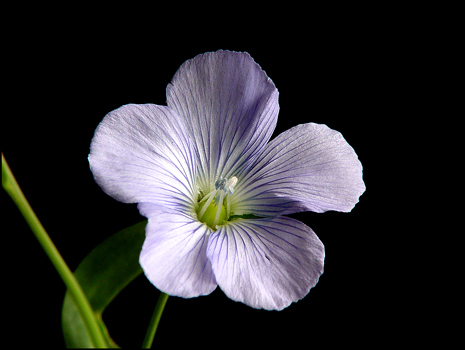|

|
A
Close-up View of the Wildflower
"Wild Blue Flax"
(Linum lewisii)
by Brian Johnston (Canada)
|
Hans Christian Anderson began his fairy
tale 'The Flax' with the words "The flax was in full bloom; it had pretty
little blue flowers as delicate as the wings of a moth, or even more so."
The description is remarkably accurate. Wild blue flax is indeed
delicate. The flower opens only in full sunlight and usually
closes shortly after noon. The petals normally drop off the same
day if there is the slightest breeze. In my area this species is
quite rare, with only four very small patches growing in full sunlight
beside an old fence. The species name lewisii refers
to Captain Meriwether Lewis, of the Lewis and Clark expedition, who
discovered this plant in Montana. A commercial version of flax (Linum usitatissimum)
that has been grown throughout history, is similar to wild blue flax,
but has a white flower. This crop is used to produce linseed oil (from the seeds) and to
manufacture the textile linen
(from the stems). The genus name Linum was
derived from the word linen.
The image above shows a typical flower with five petals and
characteristic deep purple-blue veining. Most flowers are from
one to two centimetres in diameter, and plants may grow up to thirty
centimetres high. The photograph below shows the five green
bracts (modified leaves) at the flower's base.

A closer view reveals the group of blue stamens and white pistil.
In most blooms that I studied, the anthers and stigma were fused in a
loose cluster and could be separated only with difficulty. Based
on other images that I have seen of this plant, I think this behaviour
may be atypical.
As soon as the first direct light from the sun reaches the plant, that
day's blooms begin to unfurl their petals.
If a microscope using dark-ground illumination is used to examine a
petal, both the background and blue vein cell structure can be observed.
The strange object below shows a mature set of stamens projecting out
through the ring of closed bracts. I am not certain whether the
petals have detached and the bracts have closed due to insufficient
light, or whether this is a bud about to bloom.
Microscopic examination of a wild blue flax stamen reveals a filament
supporting an anther encrusted with pollen.
Higher magnification shows that the pollen grains are almost spherical.
The side view of another stamen reveals the colourless filament and
blue anther with yellow centre.
Another image of pollen shows slight differences in the shape of grains.
The image below shows the ovary of the wild blue flax flower (green)
and the base of the style which is composed of five blue stalks.
Higher magnification reveals that these stalks are longitudinally
ridged.
The style stalks become colourless at the top where they form the
stigma. The five stigma lobes are completely covered by pollen at
their tips, but further down the pollen seems to cling to only one side.
The following image reveals the tip of one stigma. Notice in
particular the four pollen grains at the centre. They are
completely transparent! In fact, if you look closely, you will
see that they act as tiny, spherical lenses refracting the light to
reverse the images of black background and white stigma!
After the petals have fallen from the flower, both stamens and pistil
eventually wither and die. What is left can be seen in the image
below. The enlarged ovaries have become seed pods. The one
in the centre of the image has begun to turn brown as it dries out.
The two images below show a top view of one particular seed pod.
The green radial pattern is striking. Notice in the right image
that the remnants of the dried out stigma are still attached to the
ovary/seed pod. In the left image, the typical narrow blade-like
leaves of the flax can be observed.
The flax seeds contained in pods like the one below have supplied
linseed oil to the paint industry for a very long time. A flax
seed or "lin-seed" is about 40% oil by mass and pressing releases this
oil for use.
Celebrated through the centuries for its useful oil and fibers, flax
continues to provide these products today. Although the wild blue
flax investigated in this article is not valuable in the monetary
sense, its visual appeal more than makes up for this deficiency!
Photographic Equipment
The low magnification photographs
in the article were taken using a Nikon Coolpix 4500 with a combination
of natural light and the Nikon Cool light SL-1. Higher
magnification images were taken with natural light using a Sony
CyberShot DSC-F 717 equipped with a combination of achromatic close-up
lenses (Nikon 5T, 6T and shorter focal length achromat) which screw
into the 58 mm filter threads of the camera lens. (These produce
a magnification of from 0.5X to 9X for a 4x6 inch image.) Still
higher magnifications were obtained by using a macro coupler (which has
two male threads) to attach a reversed 50 mm focal length f 1.4 Olympus
SLR lens to the F 717. (The magnification here is about 13X for a
4x6 inch image.) The photomicrographs were taken with a Leitz SM-Pol
microscope (using a dark ground condenser), and the Coolpix 4500.
©
Microscopy UK or their contributors.
Published in the March
2008 edition of Micscape.
Please report any Web problems or
offer general comments to the Micscape
Editor.
Micscape is the on-line monthly magazine
of the Microscopy UK web
site at Microscopy-UK
©
Onview.net Ltd, Microscopy-UK, and all contributors 1996 onwards. All
rights reserved. Main site is at www.microscopy-uk.org.uk
with full mirror at www.microscopy-uk.net .
















